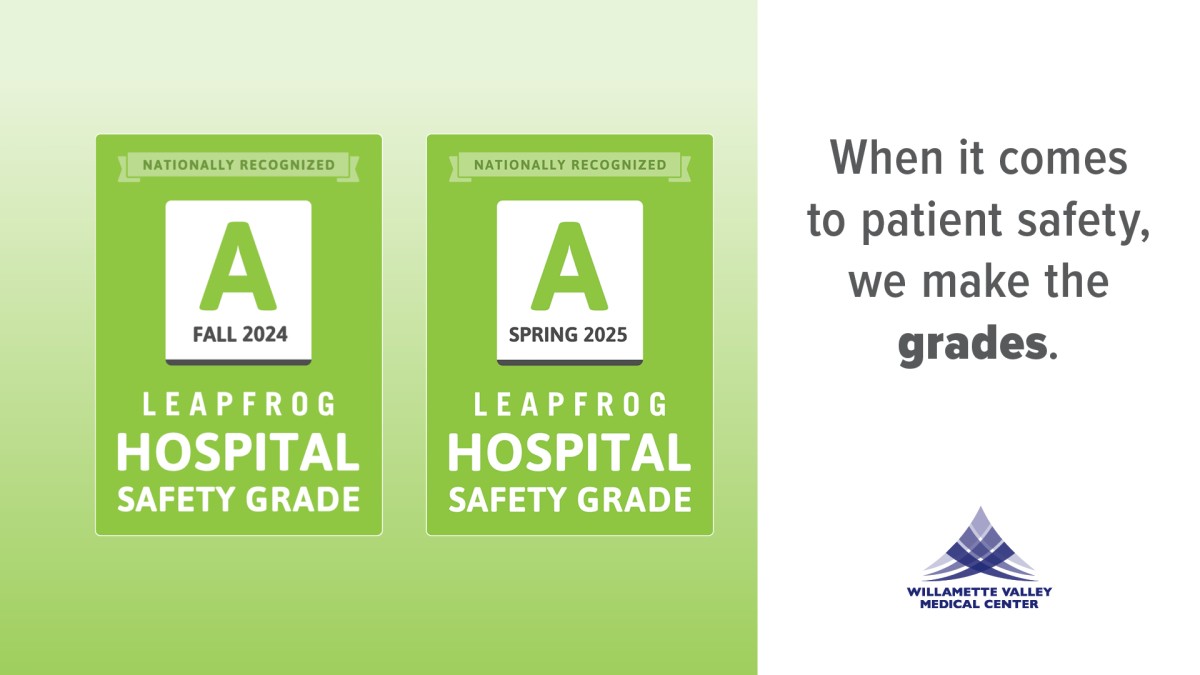In the News
-

🎓Big News from WVMC!
December 17, 2025We’re thrilled to celebrate our first graduating class of the LPN-to-RN program!Congratulations to Shelbi, Phebe, and Michael on this incredible achievement. Your hard work and dedication inspire us all, and we can’t wait to see where your nursing careers take you! The LPN to RN Apprenticeship Program is designed to support Licensed Practical Nurses (LPNs) in…
Learn more -

Willamette Valley Medical Center Earns Another “A” for Patient Safety!
December 03, 2025Willamette Valley Medical Center Achieves National Status for Patient SafetyMcMinnville, OR December 3, 2025 - Willamette Valley Medical Center was awarded an “A” Hospital Safety Grade for the third consecutive time by The Leapfrog Group, an independent national nonprofit organization focused on patient safety. “Willamette Valley Medical Center is proud…
Learn more -

New Device Helps with CPR
November 26, 2025https://newsregister.com/article?articleTitle=new-device-helps-with-cpr--1762879030--53595--
Learn more -
.jpg)
Is It a Cold, the Flu, or Something Else? How to Tell the Difference
November 26, 2025A scratchy throat. A runny nose. Fatigue that won’t quit. As we move into the colder months in McMinnville, OR, it’s natural to wonder, “Is it just a cold, or something more serious?” With cold, flu, RSV, and COVID-19 all circulating, knowing what to watch for – and when to get…
Learn more -

Veterans Day Salute
November 11, 2025Today, we honor and thank all who have served our country with courage and dedication.A special thank you to the US-Naval-Sea-Cadets-Iron-Side-Division and Representative Lucetta Elmer for their incredible support in making the WVMC Veterans Day event a meaningful tribute to our heroes. Special thank you to Mitchell Ronning for singing our national anthem. We…
Learn more -

Meet Donna – The Final Third of the Dynamic Trio
October 30, 2025Donna’s life is a tapestry of accomplishments: a thriving real estate career, a beautiful 23-year marriage to Ron, five talented children, and a heart full of gratitude. These joys bring a blush to her cheeks and a glow to her voice. They are the foundation of her strength—especially when the word cancer entered her life.But even more powerful than these…
Learn more -

Caring for McMinnville - Spotlight on Emergency Medicine
October 28, 2025Advancing Emergency Care at Willamette Valley Medical CenterWhen you think of an emergency department, words like trauma care, acute medical response, critical care, and life-saving treatment might come to mind. But what do these terms really mean for you as a patient? How quickly will you be seen? Will your urgent needs be met? Let’s take a closer look at how…
Learn more -

Meet Janis – One Third of the Dynamic Trio
October 24, 2025Janis never imagined that a small town in Oregon would become the backdrop for one of the most profound chapters of her life. But McMinnville had been quietly calling to her since 2003, when her son Jeff moved here for work. Over the years, she visited often—drawn in by the charm of the community, the laughter of her granddaughters, and the rhythm of small-town…
Learn more -
.jpg)
What Does Breast Cancer Look Like in Its Early Stages?
October 21, 2025Many people associate breast cancer with finding a lump, but in reality, early breast cancer can show up in many different ways – some of which are easy to overlook. Here are several symptoms that may indicate early breast cancer: A new lump or mass: While not all lumps are cancerous, a painless, hard lump with irregular edges should always be…
Learn more -

Meet Sharon – One Third of the Dynamic Trio
October 21, 2025If you know Sharon, you know her smile arrives before she does—radiant, genuine, and always paired with a sparkle in her eye. When Sharon and her husband, Kurt, chose to retire in McMinnville in 2019, the town didn’t just gain two new residents—it gained light. Her warmth and generosity quickly became part of the community’s heartbeat.From the…
Learn more -

The Three Musketeers - friendship, strength and giving back
October 17, 2025Have you ever walked into a room and instantly felt like you belonged—like the people you just met had been part of your story all along? That’s exactly what happened when I met Donna, Janis, and Sharon. I came expecting to hear about their breast cancer journeys, but what I found was something far deeper: a bond forged through resilience, laughter, and…
Learn more -

At the heart of food and nutrition services is Director Kari Edie
October 07, 2025Kari's unwavering pride in her work sets the tone for WVMC nutrition services team's dedication to more than just meals — they deliver comfort, care, and culinary expertise to every patient and guest.Thank you, Kari, and team!https://newsregister.com/article?page=/article&articleTitle=stopping-by-feeding-the-needs--1758900574--53105--
Learn more -

Why You Shouldn’t Skip Your Annual Physical: Screenings That Save Lives
September 26, 2025Your annual physical is more than a routine doctor’s visit — it’s an important part of long-term health planning. While many people only see a doctor when something feels wrong, preventive care helps identify risks and conditions before symptoms appear. At Willamette Valley Medical Center, our primary care teams focus on whole-person health.…
Learn more -

Willamette Valley Medical Center Launches Inpatient Renal Care and Dialysis Services
September 22, 2025Willamette Valley Medical Center (WVMC) is proud to announce the launch of inpatient renal care and dialysis services, a critical advancement in care for patients with kidney disease in our community. Opening on August 1, 2025, WVMC began offering inpatient hemodialysis through a new partnership with DaVita, in collaboration with TeleNeph nephrologists.This new service…
Learn more -

How to Protect Your Child from Fall Viruses like Flu, RSV, and COVID
September 02, 2025As colder temperatures settle in across McMinnville, OR, children are spending more time indoors – whether at school, daycare, after-school programs, or even home. These enclosed spaces make it easier for fall viruses like flu, RSV, and COVID-19 to spread. And with colder air drying out nasal passages and weakening immune defenses, kids are more vulnerable than ever…
Learn more -
.jpg)
Why Mosquito-Borne Illnesses Are on the Rise — and How to Protect Yourself
August 01, 2025Warmer weather and standing water are fueling a surge in mosquito-borne diseases. Here’s what you need to know and how to prevent them.
Learn more -

No One Dies Alone
July 15, 2025Healthcare is rooted in a profound commitment to support individuals during times of medical need. It takes someone truly exceptional to dedicate their life to this calling, and our hospital is fortunate to be filled with such individuals.
Learn more -

Willamette Valley Medical Center Names 2025 Mercy Award Winner
July 10, 2025Brandon Harris, RN, BSN, Director of Emergency Services, recognized for demonstrating compassion and providing outstanding service to patients, hospital and local community.
Learn more -

Willamette Valley Medical Center Earns Another ‘A’ Hospital Safety Grade from The Leapfrog Group
July 03, 2025Willamette Valley Medical Center (WVMC) earned an “A” Hospital Safety Grade from The Leapfrog Group, an independent national nonprofit watchdog focused on patient safety.
Learn more -

Heidi Banks Honored with Prestigious Patriot Award for Exceptional Support to Citizen Soldiers and Families
July 01, 2025The Department of Defense’s Employer Support of the Guard and Reserve (ESGR) proudly recognized Heidi Banks, Laboratory Team Leader, with the Patriot Award for her unwavering dedication to supporting employees who serve in the National Guard and Reserve.
Learn more
